Krishnapriya Vishnubhotla
The GPT-WritingPrompts Dataset: A Comparative Analysis of Character Portrayal in Short Stories
Jun 24, 2024Abstract:The improved generative capabilities of large language models have made them a powerful tool for creative writing and storytelling. It is therefore important to quantitatively understand the nature of generated stories, and how they differ from human storytelling. We augment the Reddit WritingPrompts dataset with short stories generated by GPT-3.5, given the same prompts. We quantify and compare the emotional and descriptive features of storytelling from both generative processes, human and machine, along a set of six dimensions. We find that generated stories differ significantly from human stories along all six dimensions, and that human and machine generations display similar biases when grouped according to the narrative point-of-view and gender of the main protagonist. We release our dataset and code at https://github.com/KristinHuangg/gpt-writing-prompts.
SemEval Task 1: Semantic Textual Relatedness for African and Asian Languages
Apr 04, 2024


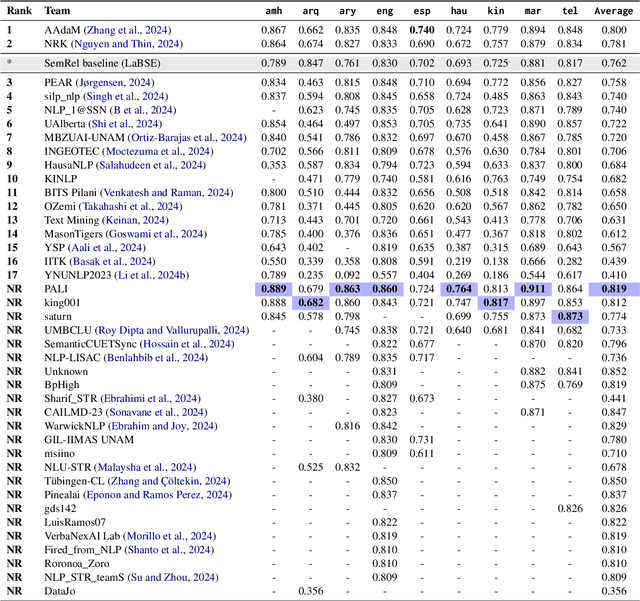
Abstract:We present the first shared task on Semantic Textual Relatedness (STR). While earlier shared tasks primarily focused on semantic similarity, we instead investigate the broader phenomenon of semantic relatedness across 14 languages: Afrikaans, Algerian Arabic, Amharic, English, Hausa, Hindi, Indonesian, Kinyarwanda, Marathi, Moroccan Arabic, Modern Standard Arabic, Punjabi, Spanish, and Telugu. These languages originate from five distinct language families and are predominantly spoken in Africa and Asia -- regions characterised by the relatively limited availability of NLP resources. Each instance in the datasets is a sentence pair associated with a score that represents the degree of semantic textual relatedness between the two sentences. Participating systems were asked to rank sentence pairs by their closeness in meaning (i.e., their degree of semantic relatedness) in the 14 languages in three main tracks: (a) supervised, (b) unsupervised, and (c) crosslingual. The task attracted 163 participants. We received 70 submissions in total (across all tasks) from 51 different teams, and 38 system description papers. We report on the best-performing systems as well as the most common and the most effective approaches for the three different tracks.
Emotion Granularity from Text: An Aggregate-Level Indicator of Mental Health
Mar 04, 2024Abstract:We are united in how emotions are central to shaping our experiences; and yet, individuals differ greatly in how we each identify, categorize, and express emotions. In psychology, variation in the ability of individuals to differentiate between emotion concepts is called emotion granularity (determined through self-reports of one's emotions). High emotion granularity has been linked with better mental and physical health; whereas low emotion granularity has been linked with maladaptive emotion regulation strategies and poor health outcomes. In this work, we propose computational measures of emotion granularity derived from temporally-ordered speaker utterances in social media (in lieu of self-reports that suffer from various biases). We then investigate the effectiveness of such text-derived measures of emotion granularity in functioning as markers of various mental health conditions (MHCs). We establish baseline measures of emotion granularity derived from textual utterances, and show that, at an aggregate level, emotion granularities are significantly lower for people self-reporting as having an MHC than for the control population. This paves the way towards a better understanding of the MHCs, and specifically the role emotions play in our well-being.
The Emotion Dynamics of Literary Novels
Mar 04, 2024



Abstract:Stories are rich in the emotions they exhibit in their narratives and evoke in the readers. The emotional journeys of the various characters within a story are central to their appeal. Computational analysis of the emotions of novels, however, has rarely examined the variation in the emotional trajectories of the different characters within them, instead considering the entire novel to represent a single story arc. In this work, we use character dialogue to distinguish between the emotion arcs of the narration and the various characters. We analyze the emotion arcs of the various characters in a dataset of English literary novels using the framework of Utterance Emotion Dynamics. Our findings show that the narration and the dialogue largely express disparate emotions through the course of a novel, and that the commonalities or differences in the emotional arcs of stories are more accurately captured by those associated with individual characters.
SemRel2024: A Collection of Semantic Textual Relatedness Datasets for 14 Languages
Feb 15, 2024



Abstract:Exploring and quantifying semantic relatedness is central to representing language. It holds significant implications across various NLP tasks, including offering insights into the capabilities and performance of Large Language Models (LLMs). While earlier NLP research primarily focused on semantic similarity, often within the English language context, we instead investigate the broader phenomenon of semantic relatedness. In this paper, we present SemRel, a new semantic relatedness dataset collection annotated by native speakers across 14 languages:Afrikaans, Algerian Arabic, Amharic, English, Hausa, Hindi, Indonesian, Kinyarwanda, Marathi, Moroccan Arabic, Modern Standard Arabic, Punjabi, Spanish, and Telugu. These languages originate from five distinct language families and are predominantly spoken in Africa and Asia -- regions characterised by a relatively limited availability of NLP resources. Each instance in the SemRel datasets is a sentence pair associated with a score that represents the degree of semantic textual relatedness between the two sentences. The scores are obtained using a comparative annotation framework. We describe the data collection and annotation processes, related challenges when building the datasets, and their impact and utility in NLP. We further report experiments for each language and across the different languages.
Improving Automatic Quotation Attribution in Literary Novels
Jul 07, 2023Abstract:Current models for quotation attribution in literary novels assume varying levels of available information in their training and test data, which poses a challenge for in-the-wild inference. Here, we approach quotation attribution as a set of four interconnected sub-tasks: character identification, coreference resolution, quotation identification, and speaker attribution. We benchmark state-of-the-art models on each of these sub-tasks independently, using a large dataset of annotated coreferences and quotations in literary novels (the Project Dialogism Novel Corpus). We also train and evaluate models for the speaker attribution task in particular, showing that a simple sequential prediction model achieves accuracy scores on par with state-of-the-art models.
The Project Dialogism Novel Corpus: A Dataset for Quotation Attribution in Literary Texts
Apr 12, 2022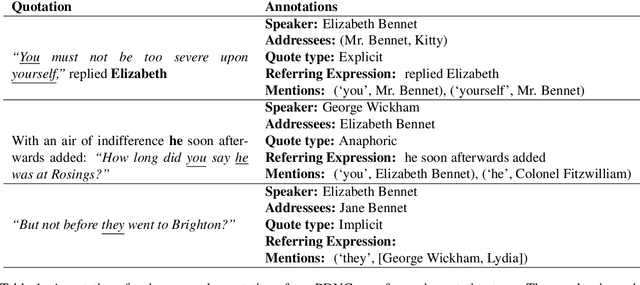
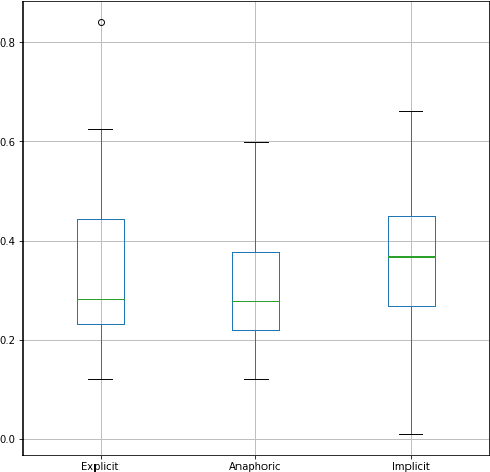
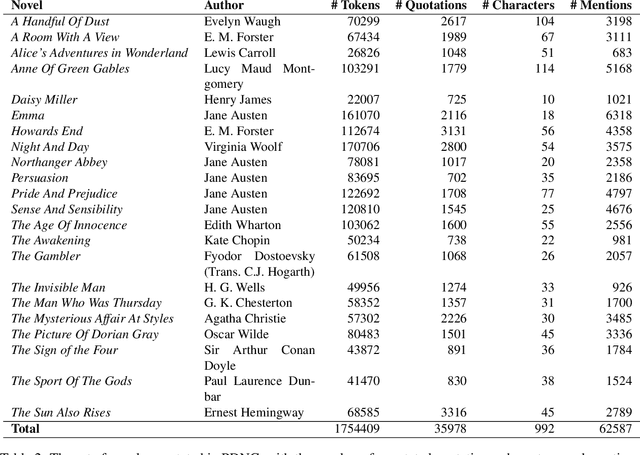
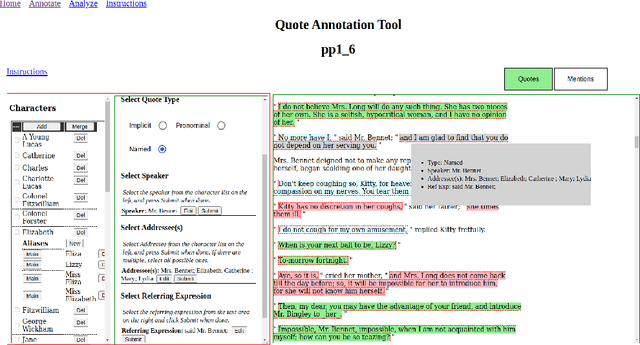
Abstract:We present the Project Dialogism Novel Corpus, or PDNC, an annotated dataset of quotations for English literary texts. PDNC contains annotations for 35,978 quotations across 22 full-length novels, and is by an order of magnitude the largest corpus of its kind. Each quotation is annotated for the speaker, addressees, type of quotation, referring expression, and character mentions within the quotation text. The annotated attributes allow for a comprehensive evaluation of models of quotation attribution and coreference for literary texts.
Tweet Emotion Dynamics: Emotion Word Usage in Tweets from US and Canada
Apr 11, 2022



Abstract:Over the last decade, Twitter has emerged as one of the most influential forums for social, political, and health discourse. In this paper, we introduce a massive dataset of more than 45 million geo-located tweets posted between 2015 and 2021 from US and Canada (TUSC), especially curated for natural language analysis. We also introduce Tweet Emotion Dynamics (TED) -- metrics to capture patterns of emotions associated with tweets over time. We use TED and TUSC to explore the use of emotion-associated words across US and Canada; across 2019 (pre-pandemic), 2020 (the year the pandemic hit), and 2021 (the second year of the pandemic); and across individual tweeters. We show that Canadian tweets tend to have higher valence, lower arousal, and higher dominance than the US tweets. Further, we show that the COVID-19 pandemic had a marked impact on the emotional signature of tweets posted in 2020, when compared to the adjoining years. Finally, we determine metrics of TED for 170,000 tweeters to benchmark characteristics of TED metrics at an aggregate level. TUSC and the metrics for TED will enable a wide variety of research on studying how we use language to express ourselves, persuade, communicate, and influence, with particularly promising applications in public health, affective science, social science, and psychology.
What Makes Sentences Semantically Related: A Textual Relatedness Dataset and Empirical Study
Oct 10, 2021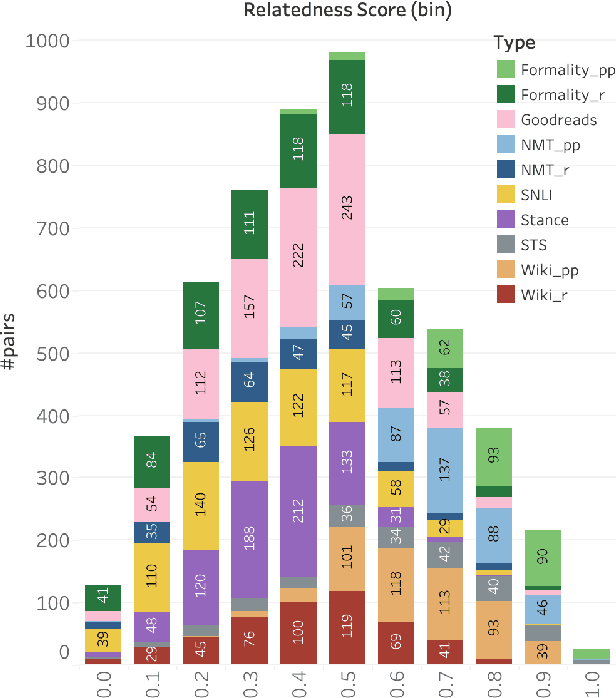
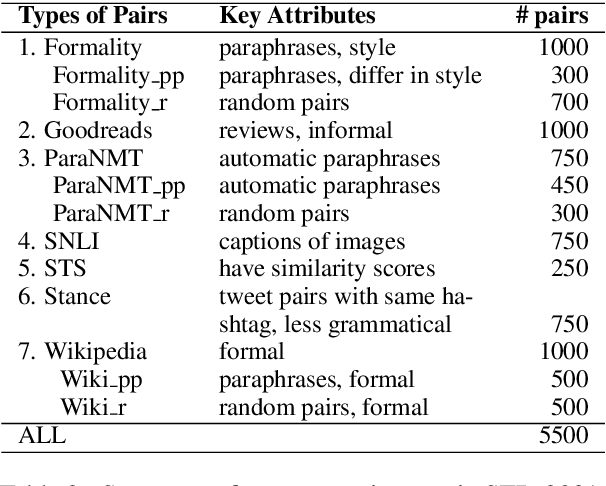
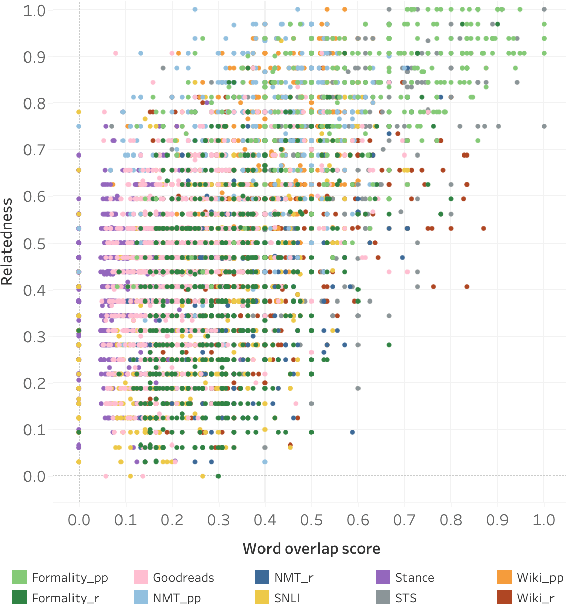

Abstract:The degree of semantic relatedness (or, closeness in meaning) of two units of language has long been considered fundamental to understanding meaning. Automatically determining relatedness has many applications such as question answering and summarization. However, prior NLP work has largely focused on semantic similarity (a subset of relatedness), because of a lack of relatedness datasets. Here for the first time, we introduce a dataset of semantic relatedness for sentence pairs. This dataset, STR-2021, has 5,500 English sentence pairs manually annotated for semantic relatedness using a comparative annotation framework. We show that the resulting scores have high reliability (repeat annotation correlation of 0.84). We use the dataset to explore a number of questions on what makes two sentences more semantically related. We also evaluate a suite of sentence representation methods on their ability to place pairs that are more related closer to each other in vector space.
Generative Adversarial Networks for text using word2vec intermediaries
Apr 04, 2019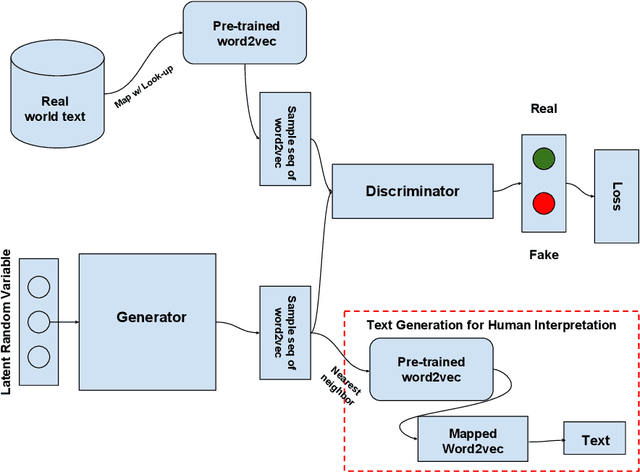
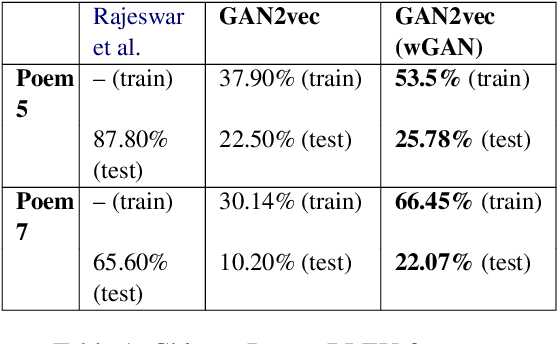
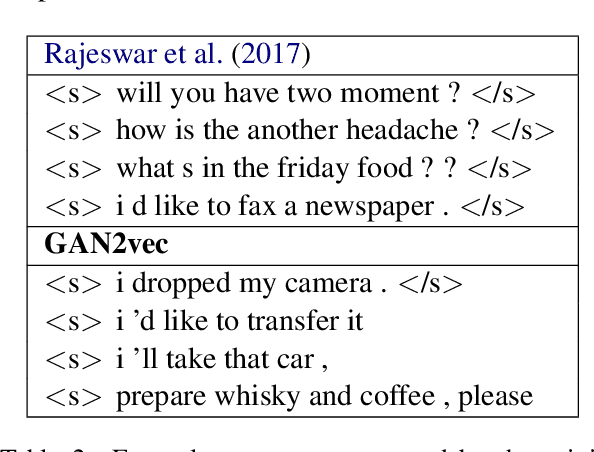
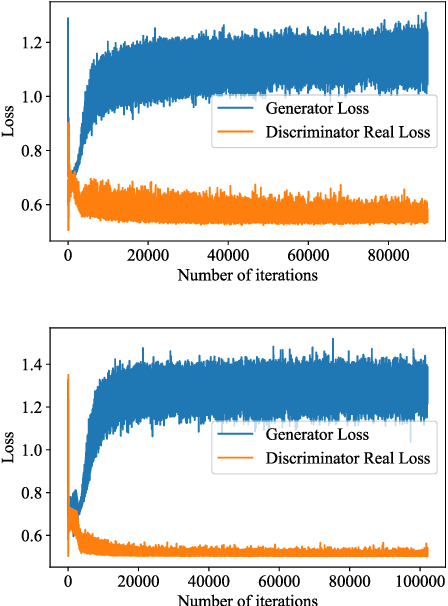
Abstract:Generative adversarial networks (GANs) have shown considerable success, especially in the realistic generation of images. In this work, we apply similar techniques for the generation of text. We propose a novel approach to handle the discrete nature of text, during training, using word embeddings. Our method is agnostic to vocabulary size and achieves competitive results relative to methods with various discrete gradient estimators.
 Add to Chrome
Add to Chrome Add to Firefox
Add to Firefox Add to Edge
Add to Edge